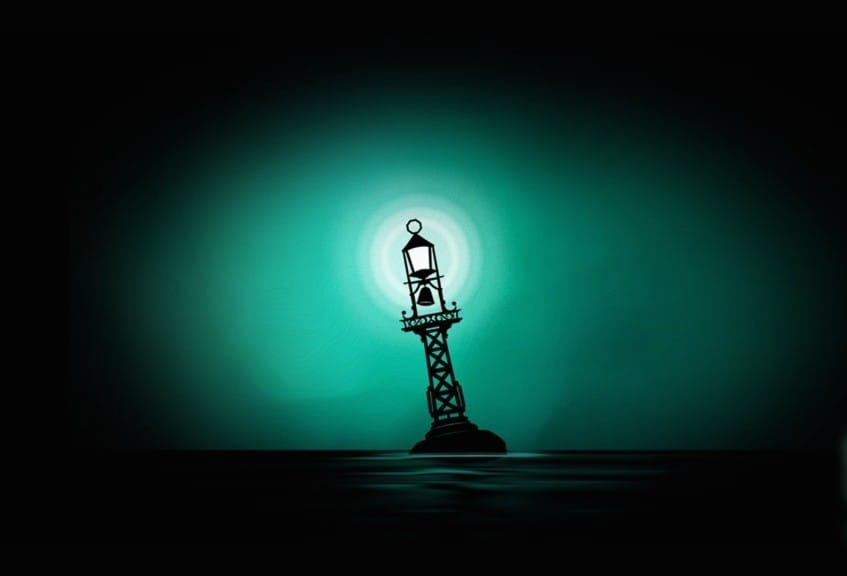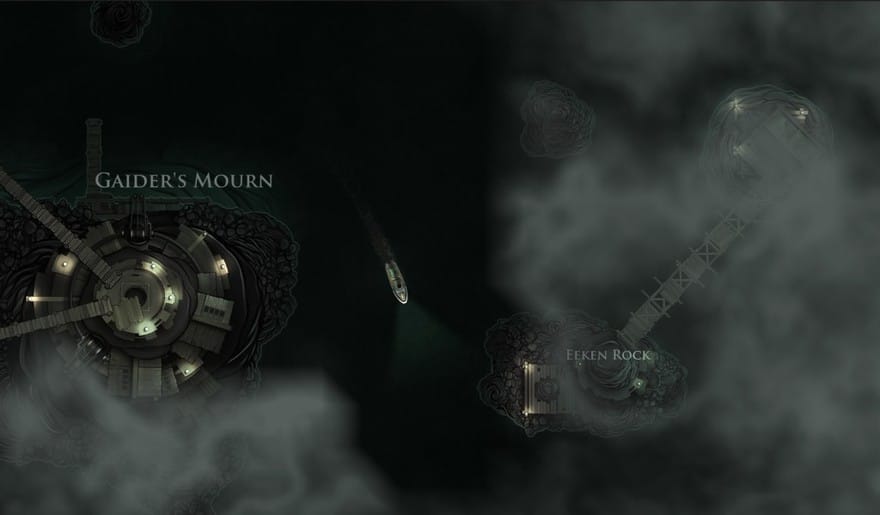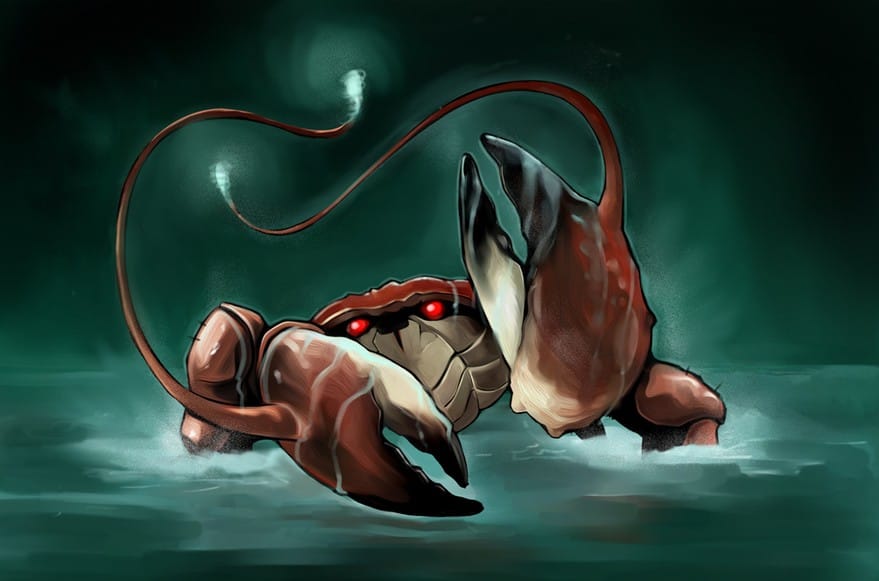The Literary Heritage of Sunless Sea

The journal was tattered but finely crafted. It had weathered the sea well. The thick pages had been hand-sewn into their leather cover. Inside, the captain’s unwavering hand told the story of his crew’s harrowing encounter with the inhabitants of the Isle of Codex. Placed with care inside a small coffin-shaped box, the journal had drifted from the place where its captain’s ship slipped beneath the waves until it reached this distant shore. Such was the story my student, Ryan, told of the items he had created for his final project in my class on nautical narratives at Georgia Tech. Ryan’s project elaborated on Sunless Sea, the game on which his project was based, by showing how the sea can become a conduit for the reception of maritime lore; in this case, the sea served to propagate a story that contributed to its own mythos. It’s precisely this kind of creative response that demonstrates how Sunless Sea interacts with the deep history of nautical literature in the nineteenth century.
As part of the multimodal curriculum in our Writing and Communication Program, I asked students to create items from one of the narratives we had studied during the semester, and Sunless Sea, the recent game from Failbetter Games, was one of the more popular choices. But before turning to videogames, we read Edgar Allan Poe’s The Narrative of Arthur Gordon Pym (1838) and Robert Louis Stevenson’s Treasure Island (1883). Most people have a passing familiarity with Stevenson’s famous novel of pirates, treasure, and adventure. In fact, in many ways it is the nautical adventure novel of the nineteenth-century. It presents the sea as a space in which fortunes are won and lost (but mostly won) and where boys learn to become men. The story evokes a vision of nautical life that is dangerous, but whose dangers are mitigated by the opportunities of adventurous expedition.

Poe’s novel, on the other hand, is not as well known, but it offers a perspective on the ocean that is far more dire (as one might expect from Poe). Pym’s tale is almost a catalogue of “worst case scenarios” including violent mutiny, shipwrecks, plague ships, deprivation and cannibalism, as well as encounters with hostile natives. Poe’s sea is one that writhes with peril, death and supernatural wonder. While the sea is presented with a certain awe, it is just as likely to kill as it is to increase your fortune. On the other hand, Stevenson’s ocean story is alive with delighted wonder, freedom and possibility. These two views of the ocean are shared throughout many nautical narratives: some privilege the danger and mysteriousness of the ocean, like Coleridge’s “Rime of the Ancient Mariner,” and others see it with more excitement, like the Aubrey/Maturin novels. What made Sunless Sea such an ideal interactive narrative for my class is the fact that it encompasses both of these narrative postures.
When it was officially released early this year, reviews compared the game’s style to that of H. P. Lovecraft and Poe, while praising its ability to encourage players to explore the “Unterzee,” the large subterranean lake on which the game takes place. Although it may not technically be an ocean, everything about Sunless Sea evokes the nautical narratives that were written during its nineteenth-century setting. Furthermore, the steampunk aesthetic that the game shares with its older sibling, Fallen London, draws players into a mysterious world of anachronistic but advanced technology dipped in Victorian nostalgia.
Here is a map that tells a story
As a companion to the game’s historical setting, Sunless Sea’s top-down perspective harks back to the real-time strategy games of the 1990s and early 2000s. As with other recent games that have found artistic value in a return to our technological forebears (like Passage and Evoland), Sunless Sea’s perspective does more than present a simplified interface: playing the game is reminiscent of looking down on a living map. Here is a map that tells a story, bringing us back to the days of Treasure Island and Flint’s map—to unroll this dusty piece of parchment is to be drawn into a grand expedition onto the sea. But maps can be unreliable, as in the case of Treasure Island, when the characters discover that the treasure isn’t buried where the map indicates that it should be. In the same way, Sunless Sea connects its visual presentation to this sense of cartographical uncertainty and volatility by changing the game’s map when a player’s captain dies. While this unpredictability can be very frustrating, it binds the game to similar elements of change in nautical narratives.
From the beginning, the game challenges expectations by showcasing constant failure as a feature rather than a flaw. Players are told that their captains will die, emphasizing the capricious misfortune of the sea, but along with that warning is an encouragement to experiment and discover what the game has in store, thereby providing a chance for adventure alongside the mortal danger. But because players can pass down some of their accomplishments (like their sea map or treasure) from one captain to the next, these deaths become narratively linked. My students found this aspect of the game particularly compelling: Sunless Sea demonstrated how narratives are built over time, as stories and experiences are passed down from one generation to the next.

By focusing on the various stories that players create through their adventures, Sunless Sea offers a distinctive narrative experience that isn’t replicated by other nautical games like Assassin’s Creed IV: Black Flag. While Black Flag offers a visually stunning recreation of the Caribbean during the early 18th century, the story itself is quite linear, thereby undercutting any notion of adventurous freedom that the game might otherwise have offered. Not only this, but Black Flag’s Caribbean feels quite cramped—land is almost always in view and the waters are chock-full of boats. Using the game’s own distance calculations while traveling between islands, I determined that Black Flag’s playable area compresses the Caribbean down to sixteen square kilometers, a good bit smaller than the real thing.
Of course, no one can expect a development studio to create a 1:1 simulation of a massive body of water for a nautical game—if such a thing were attempted, players would have to spend days sailing through open ocean before arriving at their destinations. Unfortunately, Black Flag errs on the side of a reduction so extreme that the full extent of isolation on the open sea is entirely lost. Sunless Sea, on the other hand, revels in its dark and foreboding locale so much so that sailing without a spotlight for your vessel dramatically increases your crew’s terror, which can lead to mutiny if unchecked. The game’s top-down perspective also ensures that distant islands remain shrouded beyond the edges of the screen, providing a sense that the Unterzee goes on indefinitely. As a result, feelings of isolation and seclusion are pervasive throughout the game.
feelings of isolation and seclusion are pervasive
Perhaps it is this isolation that makes the concept of a captain’s log so important to nautical travel. A captain’s notes and records presuppose a recipient—a reader somewhere on land for whom these reports will be meaningful. A recent episode of This American Life began by noting that actual captain’s logs are often quite boring documents marked by unfeeling brevity rather than the depth and intrigue that we might associate with the log entries of James T. Kirk or Jean-Luc Picard. Sunless Sea builds its narratives on something called “storylets” that take players through different adventures via very short written stories. Each island has its own share of stories, which can be read and experienced one slice at a time. As a result, each narrative segment becomes a kind of log-entry in its own right; each piece of the narrative puzzle is put in place through snippets of text that, while unassuming on their own, coalesce to form a story that is unique to each person who plays Sunless Sea. In the end, while many people might haul discarded stones from the Salt Lions back to Fallen London or perform a favor for the Dark-Spectacled Admiral, the sequence of each individual will be different, reconfiguring the story components to create a dynamic and intriguing tale.
This kind of narrative pacing is suggestive of the episodic nature of nautical narratives like 20,000 Leagues Under the Sea or Moby Dick, where each day might be a small story unto itself. My students also remarked upon the brief log entries that pop up on the bottom of the screen, while they are often ancillary to the main stories players encounter on their voyages, these bits of text maintain a perfunctory maritime tone, even in the face of fantastical events. Yet in the absence of detail, we find our imaginations filling the void, spinning out more stories than even are contained within the game’s own storylets.

My class this summer was about discovering how the sea is infused into our literary history and culture—not just in traditional written narratives, but across a variety of media. Sunless Sea is a game that builds upon that literary heritage, suffusing its content and presentation with elements that recall the terror and the joy, the adventure and the isolation, as well as the vicissitudes and the constancy of the sea. In his poem, “The Sea and the Hills,” Rudyard Kipling captures this age-old fascination with the sea as both a beneficent and maleficent force:
“Who hath desired the Sea? Her menaces swift as her mercies?
The in-rolling walls of the fog and the silver-winged breeze that disperses?
The unstable mined berg going South and the calvings and groans that declare it —
White water half-guessed overside and the moon breaking timely to bare it —
His Sea as his fathers have dared — his Sea as his children shall dare it:
His Sea as she serves him or kills?
So and no otherwise — so and no otherwise — hillmen desire their Hills.”
Kipling also alludes to the generational longevity of the sea, drawing children as it drew their parents. That vast watery part of the world has long filled the pages of human history with stories both real and imagined, and those stories will continue to have new creative life in videogames.



